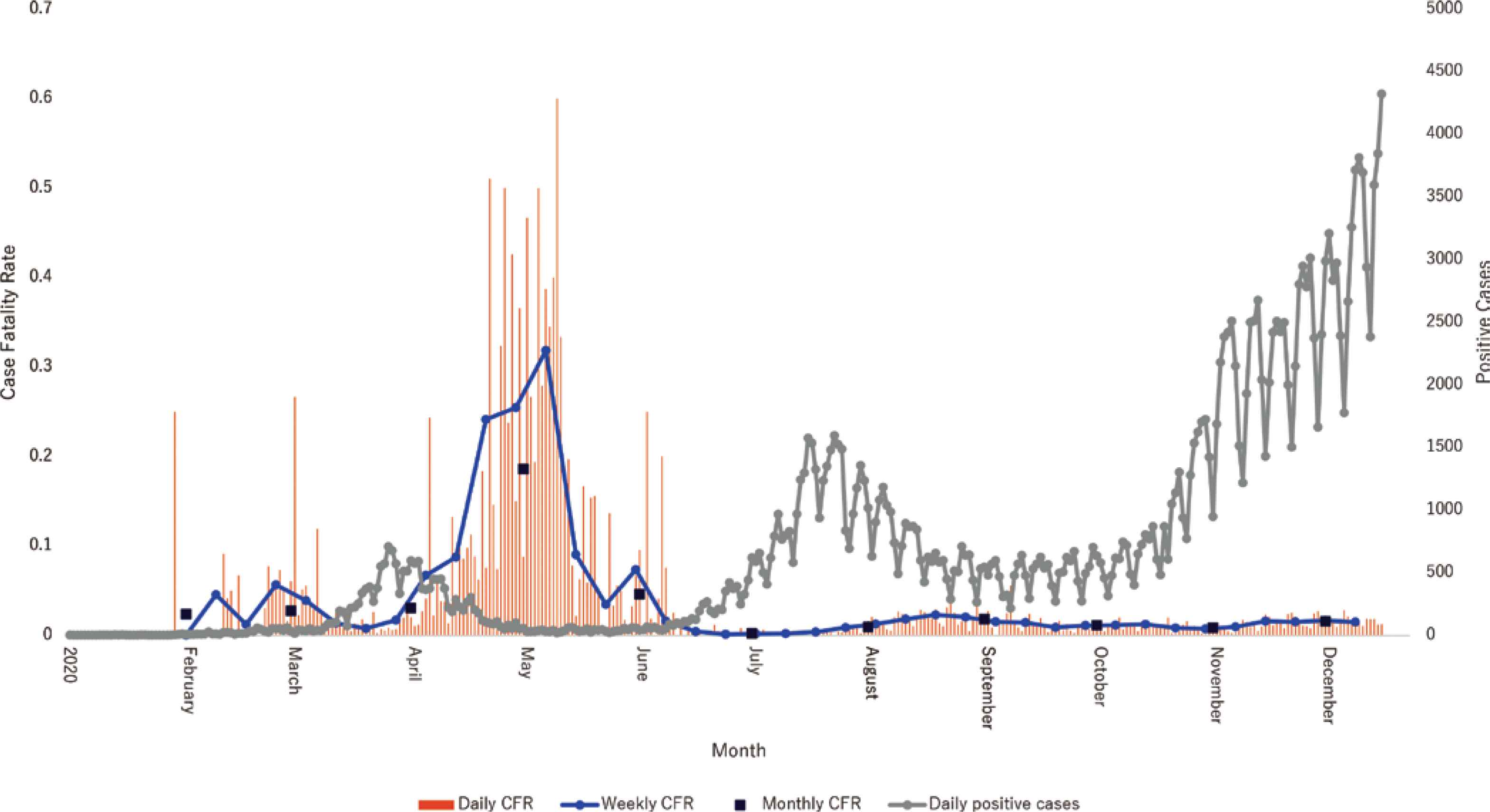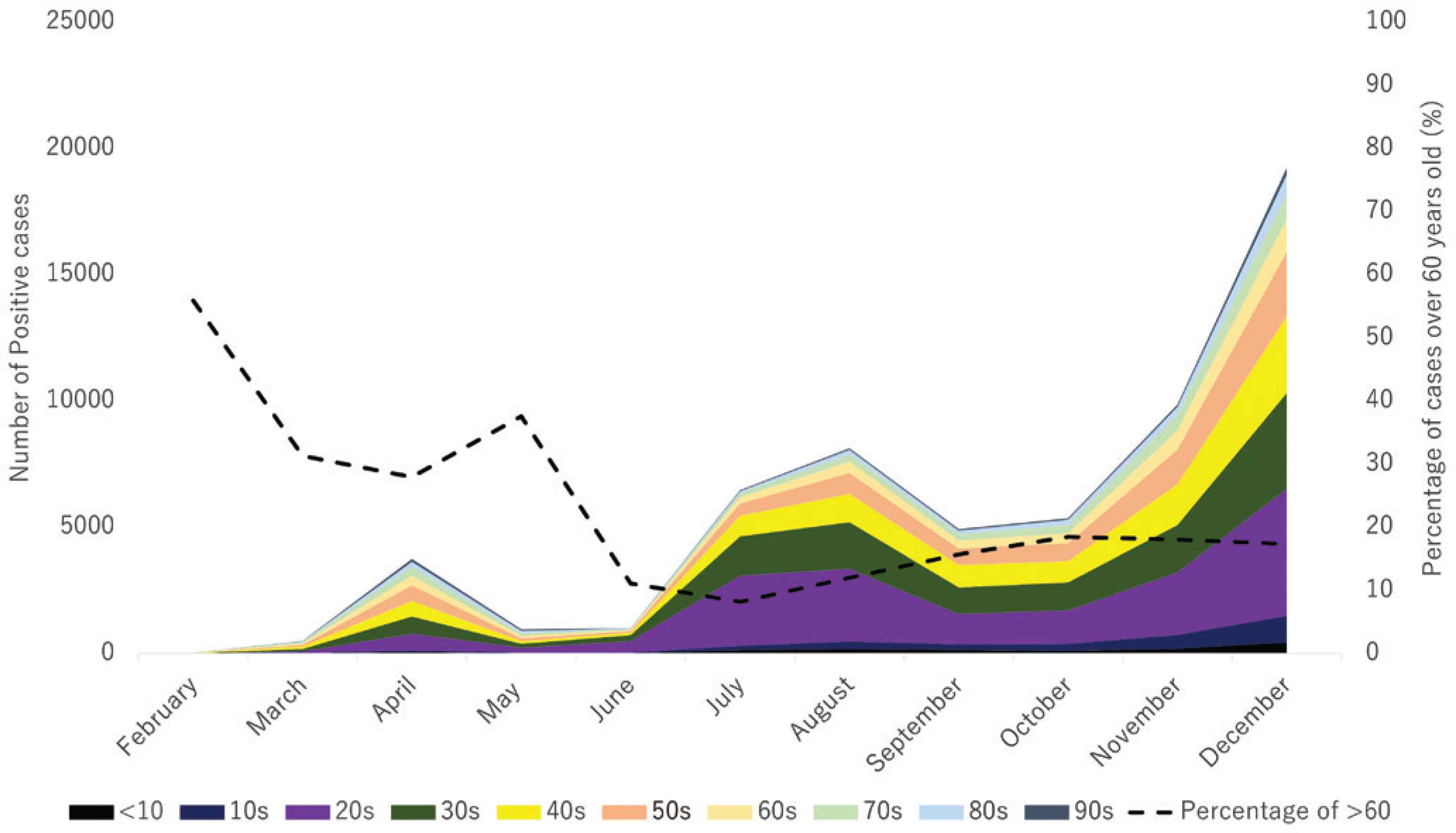Serial Monitoring of Case Fatality Rate to Evaluate Comprehensive Strategies against COVID-19
 , Daisaku Nakatani2, 3, *, Chisa Tabata2, 3, Keita Yamasaki2, 3, Ken Nakata2, 3
, Daisaku Nakatani2, 3, *, Chisa Tabata2, 3, Keita Yamasaki2, 3, Ken Nakata2, 3- DOI
- 10.2991/jegh.k.210526.002How to use a DOI?
- Copyright
- © 2021 The Authors. Published by Atlantis Press International B.V.
- Open Access
- This is an open access article distributed under the CC BY-NC 4.0 license (http://creativecommons.org/licenses/by-nc/4.0/).
Acharya et al. [1] comprehensively analyzed the present global health policies on COVID-19 especially in India and its outcomes so far, as well as proposing simple and practical frameworks to construct the necessary policies in desperate need against the pandemic. Their insights will surely be a benefit not only to India but also to the entire world community. However, to determine how big of an impact new policies presented would have upon implementation, adequate evaluation methods should also be adopted simultaneously. A good policy cannot be defined “good” unless we have a method for its evaluation. We believe that along with the number of positive cases and deaths, serial monitoring of Case Fatality Rate (CFR) should receive further attention, especially in the evaluation of policies in acute phases of the pandemic.
Case fatality rate is defined as “a measure of disease severity and is defined as the proportion of cases with a specified disease or condition who die within a specified time.” [2] This can be calculated very simply, by dividing of the cumulative number of deaths by cases in a certain period of time. However, although CFR has been used in previous pandemics to evaluate the strength of each disease, there is still argument over whether CFR can be evaluated with such an acute and ongoing pandemic such as COVID-19 due to several points. Firstly, the CFR of COVID-19 differs between the sampled location and period [3]. Therefore, the precise CFR of COVID-19 as one unique disease cannot be measured yet. Secondly, the prior calculation method may underestimate the actual risk, as deaths yet to occur from the infection are not included [4]. Finally, miscalculations also may occur due to the fact that datasets only include the number of positive cases tested which can only be identified with adequate availability of testing, and this will also be mimicked by the virus detection window and the sensitivity of diagnostic laboratory tests [5].
From another perspective, however, such dynamics of CFR in COVID-19 can possibly turn out to be a positive impact when utilized to evaluate the strategies of each nation implemented against COVID-19. The changes observed in CFR should reflect the changes in the pathogen–host pairs, such as population changes with different susceptibilities or virulence of the pathogen [6]. The main aim of policies implemented against COVID-19 would be to ultimately reduce the total health risks such as deaths related to COVID-19. Although we are aware of the potential limitations, we believe that this could be one of the openly assessable indices available for strategy evaluations during the hardships of COVID-19.
However, even if we are to implement CFR as an evaluation method for each policy, the question of how to sample the measurement period remains unanswered. To determine the optimal period for CFR measurement, we calculated the CFR of COVID-19 in Japan on a daily, weekly, and monthly basis during the year 2020. We used the open access data provided by the Ministry of Health, Labour and Welfare of Japan [7], and divided the daily number of deaths by the positive cases. We used data beginning on January 16, when the initial case was identified in Japan, to December 31, 2020, but excluded the data prior to February 12 from our study, as either the number of deaths or positive cases were zero. Our results (Figure 1) showed that compared to daily trends, the weekly and monthly trends seem to mirror each other, but the sensitivity may be different. In Japan, the number of positive cases surge three times, beginning around April, August and November, respectively. However, the CFR did not rise subsequently to the surge in August and November. This may suggest that the social and medical tactics implemented after the first surge has been effective to save patients from dying, even during the increase of the number of positive cases. In other words, this may imply the effectiveness of treatment against COVID-19 in Japan after its initial surge. One possible reason of these results in Japan may be the prevention of the elderlies becoming infected. According to the Tokyo Metropolitan Government [8], after the surge in April, the main population of the infected patients shifted to the younger generation, possibly protecting the elderlies dying from the disease (Figure 2). However, this result is not to deny that the current situation in hospitals were at a scrape with the lack of medical resources such as medical professionals and necessary medical equipment. Our analysis offers a praise to the medical staff in Japan that is literally “hanging in there”.

Case fatality rate and positive cases of COVID-19 in Japan, 2020.

Positive cases per age group in Tokyo, Japan, 2020, along with the percentage of the positive cases over 60 years old.
Considering the sensitivity and the frequency of the evaluation needed, we believe that a weekly CFR would be feasible to screen the effectiveness of policies to fight against COVID-19, taking precautions about the possible limitations stressed above. If we are to consider the delay time from onset to death, the daily CFR may not be a sufficient indicator of the effectiveness of newly implemented policies. However, for policies that require swift feedback, calculating the weekly CFR may provide provisional but relevant information. It should also be noted that more precise and accurate analysis will be possible if the number of recoveries could be included in the analysis [9,10], as well as conducting a thorough analysis including the specific details of each patients, such as their age. Although we are aware of the hardships each local and national government, as well as global organizations such as the World Health Organization is encountering with the current situation, we recommend that the number of patients that recovered from COVID-19 should be reported along with the current daily reports.
In summary, we believe that serial measurement of CFR would be useful in swiftly determining the effectiveness of strategies implemented against COVID-19, which would comprehensively include measures such as the social adaptations, policies and medical treatment. Policies and strategies should be implemented under continuous feedback from scientific evaluations in order to overcome this pandemic.
CONFLICTS OF INTEREST
The authors declare they have no conflicts of interest.
Footnotes
Data availability statement: Available on: https://github.com/soichirosaeki/opendata2021Jan
REFERENCES
Cite this article
TY - JOUR AU - Soichiro Saeki AU - Daisaku Nakatani AU - Chisa Tabata AU - Keita Yamasaki AU - Ken Nakata PY - 2021 DA - 2021/06/02 TI - Serial Monitoring of Case Fatality Rate to Evaluate Comprehensive Strategies against COVID-19 JO - Journal of Epidemiology and Global Health SP - 260 EP - 261 VL - 11 IS - 3 SN - 2210-6014 UR - https://doi.org/10.2991/jegh.k.210526.002 DO - 10.2991/jegh.k.210526.002 ID - Saeki2021 ER -
